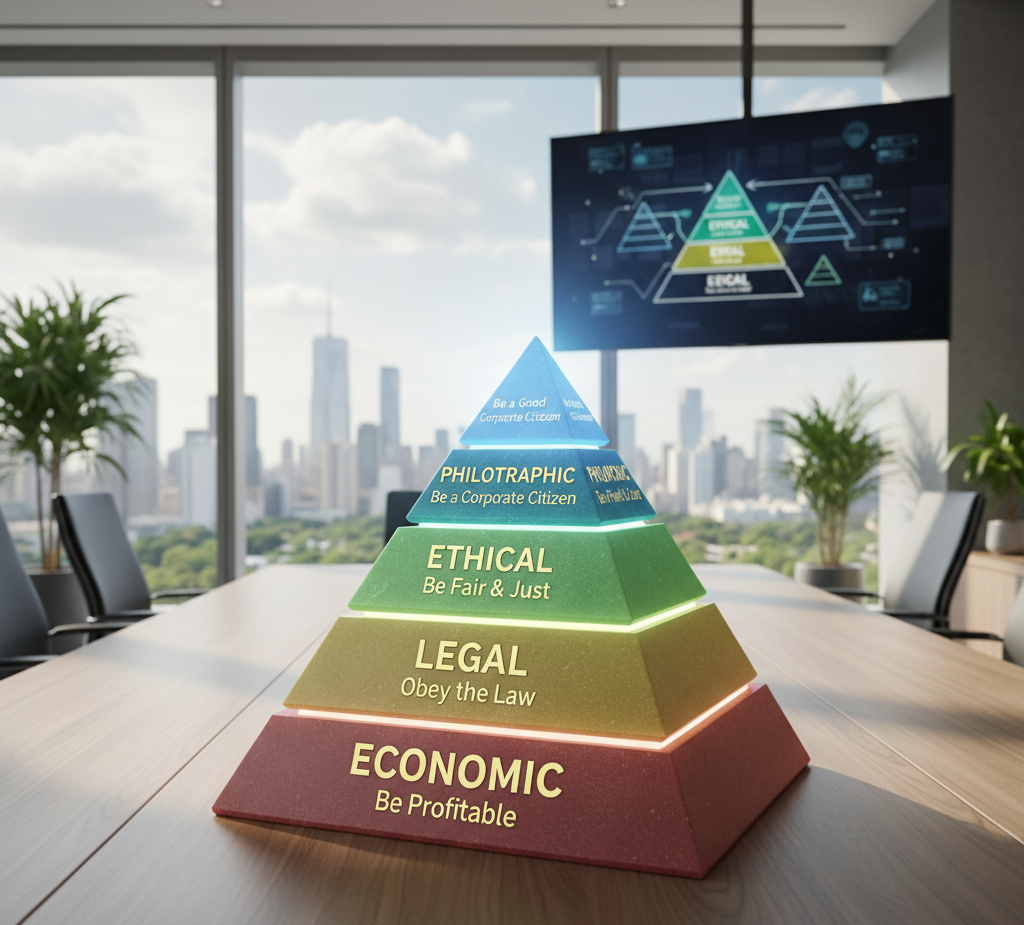When people hear the term “Corporate Social Responsibility” (CSR), they often think of charity drives, tree-planting events, or companies donating to good causes. While these are important, CSR is about much more than philanthropy. It’s about how a business operates, how it treats its stakeholders, and how it impacts society at large.
One of the best ways to understand CSR in a structured way is through the pyramid of corporate social responsibility. This simple yet powerful idea, developed by Archie Carroll, helps businesses design a CSR strategy that’s balanced, practical, and impactful.
So, how does this pyramid actually work, and how can you use it to shape your own CSR strategy? Let’s break it down.
What is the Pyramid of CSR?
Think of the pyramid of CSR as a step-by-step guide to a company’s responsibilities. Instead of seeing CSR as just “doing good,” the pyramid reminds us that businesses need to meet different kinds of responsibilities—from making money to giving back to society.
It has four layers:
- Economic Responsibility
- Legal Responsibility
- Ethical Responsibility
- Philanthropic Responsibility

Together, these form a complete CSR framework that companies can follow to balance profit with purpose.
The Four Levels of the CSR Pyramid
1. Economic Responsibility – Staying Profitable
At the base of the pyramid is the obvious one: making money. A company cannot support employees, innovate, or give back to society if it isn’t profitable. This first layer of the CSR model emphasizes financial health and long-term sustainability.
But here’s the catch: it’s not about profit at any cost. Today’s customers and investors expect companies to make money responsibly, without exploiting people or the environment.
2. Legal Responsibility – Following the Rules
The next step is about compliance. Every business operates under a set of laws—labor laws, environmental standards, fair trade practices, and so on. Meeting these requirements isn’t optional; it’s the minimum expected.
Companies that ignore legal responsibilities may see short-term gains, but they risk losing reputation and trust. Simply put: following the law is the foundation of trust with your stakeholders.
3. Ethical Responsibility – Doing the Right Thing
Here’s where the conversation gets more interesting. Ethics go beyond what’s written in the law. For example, you might not be required by law to reduce carbon emissions, but consumers may expect it. You may not be forced to pay above-average wages, but doing so creates loyalty and goodwill.
Ethical responsibility is about fairness, honesty, and transparency—doing the right thing even when no one is watching. In many ways, this is where companies truly show their values.
4. Philanthropic Responsibility – Giving Back to Communities
Finally, at the top of the pyramid is philanthropic corporate social responsibility. This includes voluntary activities like donating to local schools, funding healthcare projects, or supporting social causes.
While it’s not legally required, philanthropic responsibility shows that a business cares about more than profit. It’s about giving back and being part of something bigger. This layer often creates the most emotional connection with communities.
Why the CSR Pyramid Still Matters Today
You might wonder—why use this pyramid in 2025 when CSR has evolved so much? The answer is simple: it’s timeless.
The corporate social responsibility framework it provides ensures businesses don’t just jump into philanthropy without first securing economic and legal foundations. It creates balance.
- A company that’s only focused on profits may lose customer trust.
- A company that focuses only on philanthropy without financial strength can’t sustain it.
- A business that follows the pyramid can do both—stay profitable and make a positive impact.
How to Apply the Pyramid to Your CSR Strategy
Here are some practical steps you can take to align your strategy with the pyramid of corporate social responsibility:
- Start with your core business – Ensure your products, services, and operations are financially sustainable.
- Check your compliance – Review laws and regulations to make sure you’re fully aligned.
- Raise the bar ethically – Think about practices that go beyond compliance, like eco-friendly sourcing or inclusive hiring.
- Add meaningful philanthropy – Support causes that resonate with your brand values and stakeholder expectations.
The goal isn’t to treat these as separate boxes to tick—it’s about blending them into a holistic CSR framework.
A Real-World Example
Imagine a food company:
- At the economic level, it ensures fair pricing and profitability.
- At the legal level, it follows food safety and labeling regulations.
- At the ethical level, it chooses sustainable farming practices.
- At the philanthropic level, it donates meals to underprivileged communities.
This layered approach shows how the CSR model can guide everyday decisions while also creating long-term social value.
Final Thoughts
The pyramid of CSR isn’t just a theory—it’s a roadmap for building a strong, sustainable, and trustworthy business. By following its four levels, companies can balance financial success with social good.
When you design your CSR strategy around the pyramid of corporate social responsibility, you don’t just comply with laws or give back occasionally—you build a culture of responsibility that touches every part of your business. And in today’s world, that’s what truly sets brands apart.
FAQs on the Pyramid of Corporate Social Responsibility
1. What is the pyramid of corporate social responsibility?
It’s a model created by Archie Carroll that outlines four levels of business responsibilities: economic, legal, ethical, and philanthropic. Together, these guide companies in building a balanced CSR strategy.
2. Why is the pyramid of CSR important for businesses?
It helps businesses strike a balance between making profits and giving back to society. By following the pyramid, companies can ensure sustainability, compliance, and a positive brand image.
3. How can companies apply the CSR pyramid in real life?
Businesses can start by ensuring profitability, staying compliant with laws, adopting ethical practices, and then contributing to society through philanthropy.
4. Is philanthropy the most important part of CSR?
Philanthropy is important, but it’s only one part of the pyramid. Without strong economic and legal foundations, philanthropic activities can’t be sustained in the long term.
5. How does the CSR model benefit companies?
A strong CSR framework builds trust, attracts customers, strengthens employee engagement, and creates long-term growth while making a positive societal impact.



